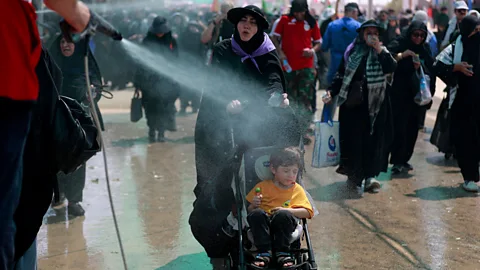Climate change: The 1.5C threshold explained
 Getty Images
Getty ImagesAs leaders gather at COP28 in Dubai to discuss the climate crisis and negotiate how the world will address it, we consider one of the most important numbers in climate change: 1.5C.
You might have read it in news headlines in the run up to COP28, the UN climate talks held this year in Dubai, UAE. You might have heard it as part of your nation's climate pledge. You might know it from the Climate Clock in New York's Union Square, a public art project and reminder of the urgency of the climate crisis.
In any conversation about climate change, the figure "1.5C" is rarely far from the discussion.
A year-long breach of the 1.5C warming limit
In February 2024, it was confirmed that the 1.5C threshold of global warming has been breached for a full 12 months for the first time, according to the EU's Copernicus Climate Change Service.
Although it doesn't break the commitments made in the Paris Agreement, it does bring the world closer to doing so in the long-term. Find out more from BBC climate reporter Mark Poynting.
But when people talk about "1.5C", what do they really mean? How do we measure it? And where did the figure come from? Is it the right target to be aiming for? And if we overshoot it, will we be able to come back below 1.5C again? Ahead of the climate summit in Dubai, we take a look at some of the questions around this key climate change figure.
What does keeping to the 1.5C threshold mean?
It means that by the year 2100, the world's average surface temperature will have risen to no more than 1.5C (2.7F) warmer than pre-industrial levels.
The 1.5C threshold was the stretch target established in the Paris Agreement in 2015, a treaty in which 195 nations pledged to tackle climate change. The agreement aims to limit global warming to "well below" 2C by the end of the century, and "pursue efforts" to keep warming within the safer limit of 1.5C.
"One-point-five has become an iconic figure," says Sir David King, former lead negotiator from the UK Foreign Office at the UN climate summit in Paris, 2015, which resulted in the adoption of the Paris Agreement.
Why 1.5C above "preindustrial levels"?
The main reason is that the industrial revolution was the time when Britain, followed by the rest of Europe, North America, Japan and other nations, began emitting large quantities of fossil carbon – carbon that would otherwise have remained locked up in oil, gas and coal deposits underground.
Industrialisation led to rapidly growing levels of greenhouse gases. These gases trap the energy from the Sun within the atmosphere, heating up the planet.
In the Paris Agreement itself, the baseline for pre-industrial measures wasn't defined. But the International on Climate Change uses a baseline of 1850-1900. That's because it's the earliest period with reliable, near-global measurements. It's true that some warming from human activity had already occurred by that point, because the industrial revolution began in the early 1700s. But having good historical data for a reliable baseline is crucial to measure changes happening today.
The 1850-1900 baseline is one that scientists, politicians, policymakers, activists and everyone talking about climate change can use and be sure they are all referring to the same thing.
 Getty Images
Getty ImagesWhere did the 1.5C limit come from?
The 1.5C "stretch target" in the Paris Agreement came as something of a surprise.
"I don't think anybody really thought that the Paris agreement would be that ambitious," says Myles Allen, professor of geosystem science at the University of Oxford, and a coordinating lead author on the IPCC's special report on 1.5C in 2018.
Measuring climate change
Degrees of warming is not the only way to look at the difference between now and the 1850-1900 baseline – it can also be expressed in the concentration of greenhouse gases in the atmosphere, measured in "parts per million", or ppm.
In the pre-industrial period and for 800,000 years or so before that, carbon dioxide levels in the atmosphere did not exceed 300ppm. In 2022, the global yearly average carbon dioxide level was 417ppm.
When you take into other gases like methane, the cumulative effect is even greater.
The 1.5C target was based on assessments of the impacts of climate change at different levels of warming. For instance, the IPCC report found that at this temperature, extreme heat is significantly less common and intense in many parts of the world than at 2C. And at the other extreme, the coldest nights at high latitudes warm by around 4.5C when the world is at an average of 1.5C warming. That figure is especially important for the future of sea ice in the polar regions. At 2C warming, the coldest nights warm by around 6C.
"Before the Paris Agreement there wasn't really a focus point for the world to aim for, to reduce the climate change process," says Pauline Dube, an environmental scientist at the University of Botswana, also a coordinating lead author on the IPCC's 1.5C report.
"To have had a situation where the world agreed on a target figure – that was a significant development in the climate change community."
Is 1.5C a safe level of warming?
In a 1.5C world, many of the deadliest effects of climate change are reduced. Sea level rise is expected to be around 10cm (4in) lower at 1.5C compared with 2C. However, irreversible melting of ice sheets on Greenland and Antarctica could be triggered between 1.5C and 2C, meaning that sea levels would continue to rise well beyond 2100. But it would happen more slowly at 1.5C than 2C, buying time for communities to adapt.
For small island nations and low-lying nations already seeing storms, rising sea levels and degradation of land and reefs, 1.5C would still pose an existential challenge. Loss and damage funding is seen as crucial for the long-term survival and adaptation of small islands and low-lying nations, as well as other nations especially vulnerable to climate change.
Compared with today, a 1.5C world would also be at increased risk of extreme heat, stresses on food production and access to water, and the range of insect-borne diseases such as malaria and dengue fever, among other threats.
The damage done at the 1.5C threshold also depends on how we get to 1.5C. If we overshoot 1.5C in the 21st Century and then reduce warming back to 1.5C (an "overshoot"), the risks are greater than if the world gradually stabilises at 1.5C. The peak temperature of the century will also have a big impact on the survival of ecosystems, such as tropical corals.
But have we not ed the 1.5C threshold already?
The year 2023 is on track to be the hottest on record. It brought the world's hottest July in 120,000 years, and September was also the hottest on record by a large margin.
The global average daily temperature was more than 1.5C more than the preindustrial average for roughly one-third of days in 2023. Needless to say, this was a record number of days above the 1.5C daily limit.
